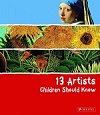|
13 Artists Children Should Know

Last updated Tuesday, September 10, 2024
Author: Angela Wenzel
Date of Publication: 2009
ISBN: 3791341731
Grade Level: 4th (GLCs: Click here for grade level guidelines.)
Date(s) Used: Sep. 2024
Synopsis:
This heavily illustrated book featuring the world's greatest painters is an excellent introduction for young readers to artists and their works.
Whether it's Leonardo da Vinci’s mysterious Mona Lisa, Vermeer's vibrant depictions of light, Van Gogh's mesmerizing brush strokes, or Matisse's playful cutouts, the art featured here is introduced in a format and style that will appeal to children. The book proceeds chronologically, accompanied by a timeline to offer helpful historical context. Each artist's entry includes a concise biography, beautiful reproductions of major works, and lively texts that speak directly to young readers. Games, quizzes and other activities help readers learn about the significant contributions of each artist in a way that is both fun and inspiring.
| Note to readers: |
| • |
This book is written as though the reader is seeing the artwork in a museum. It may be preferable to read this as a picture book showing the kids different artwork and based on interest read about the specific pictures. If attention allows, read about the artist for that section. There is a glossary on page 45-46 which defines the various types of art style used by the artists. There are nude pictures, Da Vinci (p7), Rousseau, (p15) and Mattise (p23). These images can be tied to the word anatomy, found in the glossary of the book.
|
| Discussion topics for before reading: |
| • |
What art projects have you done recently? Where did you put your favorite piece of artwork that you made?
|
| • |
What is the art supply you must have when you do an art project? I.e, glue stick, tape, scissors, crayons, markers, etc.
|
| • |
When you draw something does it have to look like something you see everyday? For instance when you draw people can they be a mixture of animal and person?
Vocabulary
|
| • |
Anatomy-The structure of the body. Anatomy also refers to the branch of medicine which looks into the from and structure of the body and its organs.
|
| • |
Restoration-The process of repairing a damaged piece of artwork or building to its prior condition.
|
| • |
Expressionism-A painting style developed in 1911 that shows the external appearance of an object or person through the artist's eyes
|
| Discussion topics for during/after reading: |
| • |
Do you think that the woman painted in the Mona Lisa is smiling? Why?
|
| • |
Who was your favorite artist in the book?
|
| • |
Did you like the bright colored artwork or the artwork that had duller colors?
|
| Craft ideas: |
| • |
Copy or make up your own artwork from your from an artist in the book. Make sure you take it to school and ask your teacher to hang it.
|
| • |
Take colored construction paper and cut out people without drawing them first. Take your artwork to school and ask your teacher to hang it.
|
| • |
Have kids trace or color in any of the printed templates provided with this book
|
*Note: These craft ideas are just suggestions.
You can use them, but you don't have to use them.
You can expand upon them, or add your own twist.
Remember, though, that the focus of your time should
not be on the development and execution of a craft;
the focus should be on the read-aloud and the
enjoyment of the book!
|
